
1. Benchmark Assessments
2. Assessing Student Learning Ch.13
2.1. Instructional Objectives
2.1.1. What are they?
2.1.2. How are they used?
2.2. Behavioral Objective
2.2.1. performance
2.2.2. conditions
2.2.3. criteria
2.2.3.1. task analysis
2.3. Background Planning
2.4. Planning
2.4.1. long
2.4.2. middle
2.4.3. short
2.5. Objective
2.5.1. assessment
2.6. Bloom
2.6.1. Knowledge
2.6.1.1. Comprehension
2.6.1.1.1. application
2.6.1.1.2. analysis
2.6.1.1.3. synthesis
2.6.1.1.4. evaluation
2.7. Behavior
2.7.1. content matrix
2.8. Beyond!
2.8.1. Effective=
2.9. Evaluation
2.9.1. Feedback
2.9.1.1. students
2.9.1.2. teachers
2.9.2. Information
2.9.2.1. Parents
2.9.2.1.1. Selection
2.9.3. Incentive
2.10. TESTS
2.11. Achievement
2.11.1. Traditional
2.11.1.1. portfolio
2.11.1.1.1. performance
2.11.2. Selected Response
2.11.2.1. constructed response
2.11.2.1.1. essay
2.11.2.1.2. problem solving
2.12. Grades
2.12.1. absolute
2.12.1.1. relative
3. Standardized Tests and Accountability Ch. 14
3.1. What are Standardized Tests?
3.1.1. Carefully Constructed
3.1.1.1. Measures and Compares Student Performance
3.2. How are Standardized Tests Used?
3.2.1. Selection and Placement
3.2.2. Diagnosis
3.2.3. Evaluation
3.2.4. Accountability
3.2.5. School Improvement
3.3. What Types of Standardized Tests Are Given?
3.3.1. Aptitude
3.3.2. Norm Referenced Achievement
3.3.3. Criterion Referenced Achievement
3.4. Test Validity
3.4.1. content evidence
3.4.2. criterion related evidence
3.5. How are Standardized Tests Interpreted?
3.5.1. Percentile Scores
3.5.2. Grade Equivalent Scores
3.5.3. Standard Scores
3.6. Issues?
3.6.1. Test Reliability
3.6.2. Test Bias
3.7. Accomodations
3.7.1. Computerized Tests
3.7.2. Students with Disabilities
3.7.3. English Learners
3.8. Accountability
3.8.1. Districts
3.8.1.1. Schools
3.8.1.1.1. Principals
3.8.1.1.2. Teachers
3.8.2. No Child Left Behind
3.8.2.1. Annual Testing
3.8.2.2. Disaggregated Reporting of Scores
3.8.3. Common Core Standards
3.9. How Can We Use the Data?
3.9.1. Data Driven Reform
3.9.1.1. Identify Problem
3.9.1.2. Adequate Yearly Progress
3.9.1.2.1. Consequences if not reached
3.9.1.3. Collect Data
3.9.1.4. Analyze Results
3.9.1.5. Set Goals
3.9.1.6. Develop Strategies
3.9.2. Value Added Assessment Systems
4. Effective Learning Environments Ch. 11
4.1. Time
4.1.1. Effective use of time
4.1.2. Students engaged
4.1.3. Don't over do it
4.2. Classroom Management
4.2.1. Setting Class Rules
4.2.2. Start the year right
4.3. Managing Misbehaviors
4.3.1. Principle of Least Intervention
4.3.2. Prevention
4.3.3. Cues
4.3.3.1. Verbal
4.3.3.2. Non Verbal
4.3.4. Use of Praise
4.3.5. Consequences
4.4. Applied Behavior Analysis
4.4.1. Principles
4.4.1.1. Identify
4.4.1.1.1. behaviors
4.4.1.1.2. reinforcers
4.4.1.2. Establish Baseline for Target Behavior
4.4.1.3. Choose
4.4.1.3.1. Reinforcer Criteria
4.4.1.3.2. Punishment Criteria
4.4.1.4. Observe Behavior
4.4.1.5. Adjust
4.4.1.5.1. Increase frequency of reinforcement
4.4.1.5.2. Decrease frequency of reinforcement
4.4.2. Programs
4.4.2.1. Home Based Reinforcement
4.4.2.2. Daily Report Cards
4.4.2.3. Group Contingency
4.4.3. Ethics
4.4.3.1. Use Wisely
4.4.3.1.1. Can lead to manageable classroom
4.4.3.1.2. Can lead to overcontrol
4.4.4. Prevention of Serious Behavior Problems
4.4.4.1. Preventative Programs
4.4.4.2. Identify Cause of Misbehavior
4.4.4.3. Enforce Rules and Practices
4.4.4.3.1. Fast and Fair
4.4.4.3.2. Be Consistent
4.4.4.4. Enforce School Attendance
4.4.4.4.1. reward attendance
4.4.4.4.2. call parents when student absent
4.4.4.5. Practice Intervention
4.4.4.6. Request Family Intervention
4.4.4.6.1. Ask parents to use a reinforcement system at home
4.4.4.6.2. Keep the parents informed
4.4.4.7. Use Peer Mediation
4.4.4.7.1. Train
4.4.4.7.2. Monitor
4.4.4.8. Confront Bullies
4.4.4.8.1. Develop School Wide Bullying Policy
4.4.4.8.2. Educate Students About Bullying/Negative Effects
4.4.4.8.3. Provide Training in social skills
4.4.4.8.4. Monitor Locations with high frequency of incidents
4.4.4.8.5. Establish Consequences for Bullying Behavior
4.4.4.9. Judiciously Apply Consequences
